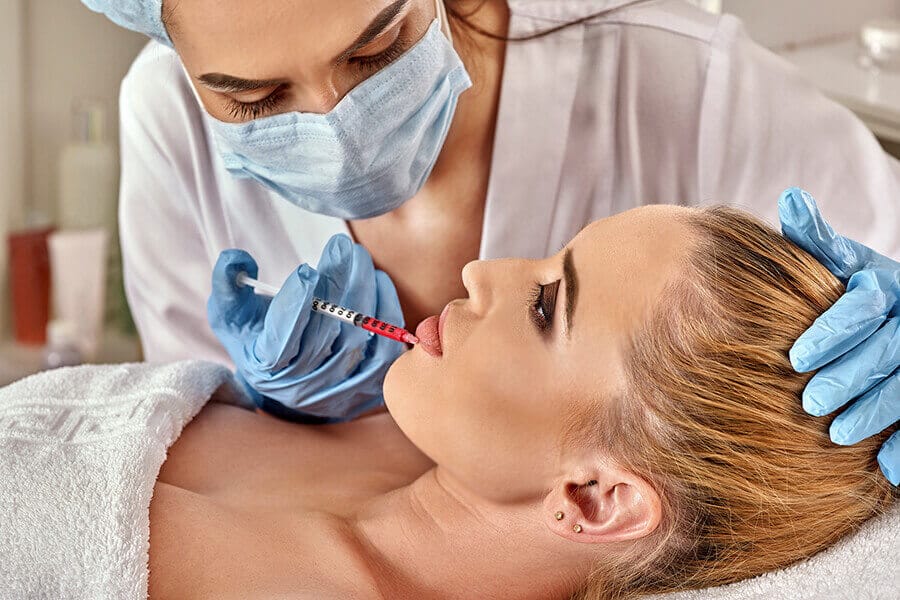Dermal fillers have been in use for some time now, helping many people with wrinkles, crow’s feet, recessed scars, and thin lips. As we age, we slowly begin to lose the subcutaneous fat cells that support the structure of our faces, leading to the subtle signs of aging we all associate with growing older. Some people lose this fat layer sooner than others, and many factors can contribute to the loss of facial volume. Of these, overexposure to the damaging rays of the sun can be one of the most important, but other factors like heredity and age play important parts as well. Dermal fillers are injected into the face and lips, restoring the look of fullness we associate with youth. They can also help increase the benefits of rejuvenation surgery. Even though treatment with dermal fillers is usually well-tolerated by most individuals, as with any medical procedure, they have their share of side effects. These include:
- Allergic reactions
- Tiny bumps under the skin
- Bluish skin discoloration
- Death of skin cells
- Blindness
- Nerve Paralysis
Allergic Reactions
Allergic reactions are the most common form of side effects associated with dermal fillers. They can include swelling, redness, bruising, and pain at the injection site. These reactions can pass quickly or last longer, depending on the individual’s body chemistry. In addition, redness and swelling can be just a normal reaction to receiving facial injections, in this case, the symptoms will usually get better within a few hours.
Tiny Bumps Under the Skin
Another fairly common side effect of dermal fillers is the formation of tiny bumps under the skin. These bumps can sometimes be permanent. Again, your own body chemistry can react to the type of fillers used, leading to tiny bumps or lumpiness near the sites of the injections.
Bluish Skin Discoloration
Known as the Tyndall effect, and named for the scientist who described it, this side effect is the result of a dermal filler that is not injected far enough under the skin. If it is not injected deeply enough, the clear gel of the dermal filler will appear bluish when light reflects through it.
Death of Skin Cells
The death of skin cells is a rare side effect of having dermal filler injections. It normally only occurs when something goes wrong and an infection develops at or near the injection site. And it can sometimes occur when the skin is significantly damaged as a result of the procedure. This side effect happens most often when injections take place in the center of the forehead, where “frown lines” are most common, and when the fillers are injected near the lips. This side effect can cause scarring, and it can require additional treatment.
Blindness
Occurring much less often on the spectrum of side effect frequency, blindness has been reported as a very rare side effect of dermal filler injections. Dermal fillers have not been approved for injection around the eyes, and when they are used to fill wrinkles under the eye, the fillers can make their way through the small blood vessels into the eye’s artery, blocking the blood supply.
Nerve Paralysis
Like blindness, nerve paralysis is a very rare side effect of dermal filler injections. Dermal fillers like Botox and Myobloc work because they are a pure form of botulism toxin, causing a minor form of temporary muscle paralysis. But the botulism toxin can move to cause muscle paralysis in muscle groups for which it is not intended. If it travels to the throat or respiratory muscles, difficulty in swallowing could develop.
How to Protect Yourself and Minimize the Risks of Dermal Fillers
It is important to note that, even with this list of possible side effects, dermal fillers are used by millions of people without any adverse side effects at all. The key to their safe use is the practitioner you choose to administer them. Choosing a trained and experienced professionals to give you dermal filler treatment is probably the most important step you can take to ensure that you will not experience problems. To this end, here are some hints that can help you get the treatment you need.
- Don’t let anyone except a trained medical doctor or dentist treat you with dermal fillers. If you are offered dermal fillers as part of a spa package, on a cruise, or in a hotel or resort, run the other way. Only medical doctors and dentists are trained to use dermal fillers appropriately.
- Ask your doctor or dentist what kind of dermal fillers they are offering. Ask if they are approved by the FDA, and then ask if they came directly from the maker. Discuss your skin type and other concerns with your professional to make an informed decision about what type of dermal filler will work the best for you. If the answers to any of these questions seem shady or incomplete, run the other way.
- Never let the prospect of a “bargain treatment” sway you from taking the precautions mentioned above. If someone offers you a deep discount, it is more than likely that some type of shortcuts is in play. The cost of dermal fillers are fairly consistent, and you are paying for a medicine that should be safe.
In Conclusion
Dermal fillers can be a great way to bring out your youthful appearance. And when you take some common-sense precautions, the benefits of dermal fillers will far outweigh any side effects.

